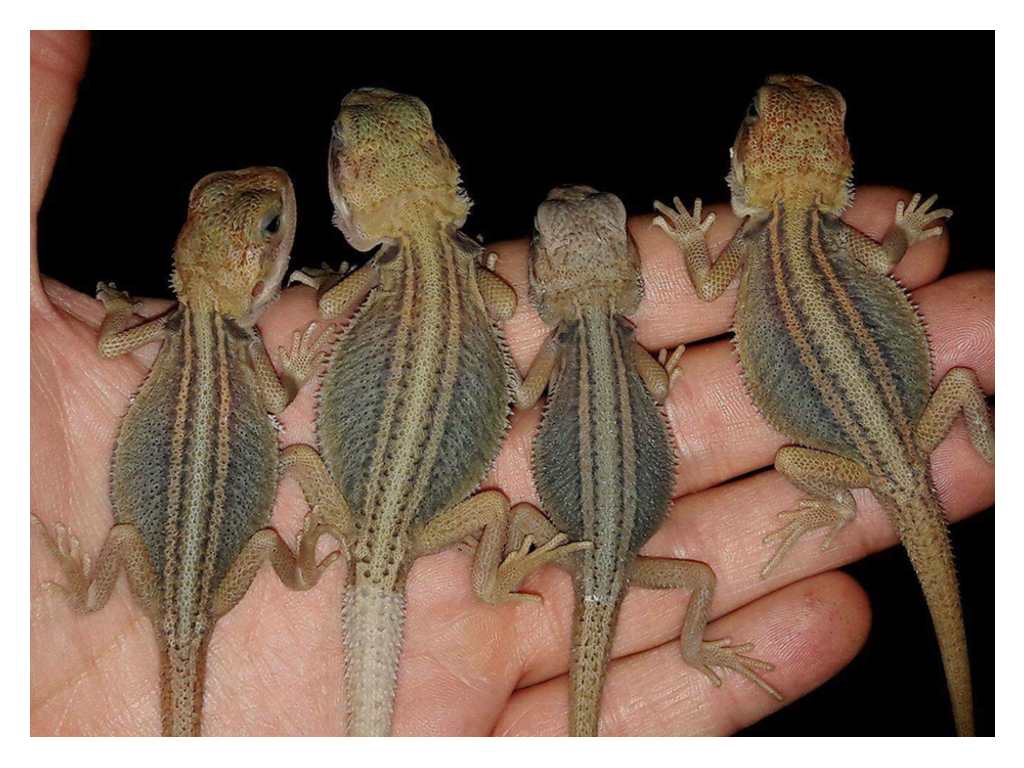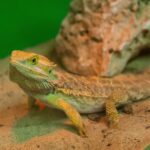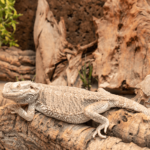A lot is said and written, but a true Leucistic Bearded dragon still remains undiscovered, so its existence has also not been proven yet. Almost every species of animals contain a Leucistic form, so the genetic disorder truly exists, despite the lack of evidence (even though rumours may dispute this).
If you intend to buy a Leucistic Bearded dragon that shows colour, this animal is a lightly coloured Hypo or Mark. Leucistic instead of a true Leucistic. How to be sure about buying a Leucistic Bearded dragon? The only way to find out is breeding the Leucistic to a Hypo. Why? Hypo and Leucistic are two completely different genetic profiles. A fake Leucistic x Hypo will result into white nailed offspring. This implies two genetically identical parents, both Hypos!
A true Leucistic x Hypo will result into standard looking offspring. The parents are genetically different, so they can’t realize Leucistic or Hypo offspring. Their standard looking offspring will carry a Hypo gene from one parent and a Leucistic gene from the other parent; they are so-called double heterozygous (abbreviated to HET). After breeding such a double HET animal with a true Hypo, will result into a partly Hypo offspring. Breeding with a true Leucistic will result into a partly Leucistic offspring.
But how about the Mark. Leucistic? Mark. Leucistics are an existing blood line, the breeder thought he had discovered the genetic disorder (the disability of producing colour) leading to Leucism*. This appeared to be wrong, so the phrase Marketed was added, to show that this line does not contains true Leucistic animals. A Mark. Leucistic is actually a very lightly coloured Hypo, almost white (not to be confused with albinism**). The suffix “Het. Leucistic” behind the morph name of a Bearded name should be read as “Het. Mark. Leucistic” or simply “Het. Hypo”.
* Leucism: melanin is absent in (the major part of) the body, for example white animals with black pupils. Something goes wrong during transport of pigment to the cells.
** Albinism: melanin is completely absent, for example white animals with red pupils. No pigment is produced at all.
 Hypo is actually an abbreviation of the word hypomelanistic. This word implies a Bearded dragon with a diminished dark pigmentation. Hypo means less and melanistic means pigmented. Black pigments are produced, but not transported. This results into a lightly coloured appearance compared to a standard coloured Bearded dragon. Some standard animals are lightly coloured, but not a Hypo. They differ from true Hypo’s, because they lack the heritable genetic disorder that is transferred through generations. The difference is found within the genotype and phenotype. The genotype (genes) of a Hypo is completely difference, while phenotype (the way they look like) can be almost identical.
Hypo is actually an abbreviation of the word hypomelanistic. This word implies a Bearded dragon with a diminished dark pigmentation. Hypo means less and melanistic means pigmented. Black pigments are produced, but not transported. This results into a lightly coloured appearance compared to a standard coloured Bearded dragon. Some standard animals are lightly coloured, but not a Hypo. They differ from true Hypo’s, because they lack the heritable genetic disorder that is transferred through generations. The difference is found within the genotype and phenotype. The genotype (genes) of a Hypo is completely difference, while phenotype (the way they look like) can be almost identical.
But how to recognize a true Hypo? Look at their nails: true 100% Hypo’s carry twenty clear white nails, one at every toe. One black nail implies a standard, lightly coloured Bearded dragon, not a Hypo. The white nails of a Hypo are often accomplished by lightly coloured shoulder pads; a standard animal has black shoulder pads, a Hypo has blue/greyish ones.
How does a Bearded dragon becomes hypomelanistic? Hypomelanism is caused by a malfunctioning melanin (pigment) production or its transport to pigmented cells (melanophores). This genetically determined disorder is called hypomelanism. This name is only to be used for animals (with 100% clear nails) originating from a blood line, that’s showing this recessive genetic disorder during generations.
Heterozygous for Hypo (abbreviated to Het. Hypo) implies the presence of the Hypo gene within a Bearded dragon, without showing it. His appearance is standard; no white nails, darker pigmented compared to a 100% Hypo and often carrying black shoulder pads. However, these animals are still interesting due to the presence of the Hypo gene. They are also lightly coloured compared to standard coloured Bearded dragons, causing the colours to emerge better. Breeding a Het. Hypo with a 100% Hypo will result into a certain amount of 100% Hypo offspring. The rest of the offspring will be heterozygous (without the looks of a Hypo), carrying the Hypo gene. Of course trust is an important issue when buying a Het. Hypo; you simply can’t see the Hypo gene and the seller can only give you its word.
This schedule will provide some additional information, these percentages are based on theory, practice will often give another result.
| Het. Hypo | 100% Hypo | Normal | To be called: | |
| 100% Hypo x normal | 100% | 0% | 0% | – |
| 100% Hypo x 100% Hypo | 0% | 100% | 0% | – |
| 100% Hypo x Het. Hypo | 50% | 50% | 0% | – |
| Het. Hypo x Het. Hypo | 50% | 25% | 25% | 66% Possible Het. Hypo |
| Het. Hypo x normal | 50% | 0% | 50% | 50% Possible Het. Hypo |
The beautiful and interesting aspects of a Hypo: a 100% Hypo often shows lightly coloured pastel colours (nowadays beautifully coloured Hypo’s are developed). From our experience, their colours are and remain bright compared to a coloured (non Hypo) Bearded dragon.
|
These animals are well recognizable by their genetic disorder; they carry large pieces of translucent (transparent) skin. It’s most extreme in young animals, with aging the skin will thicken. However, the translucent appearance remains. The genetic disorder implies the lack of white pigments. The iridophores* and leucophores** are missing, they lack white pigment. Light is able to pass through, giving a clear translucent effect.
The original translucents lost their colour at adulthood and looked like standard Bearded dragons. They did keep their black pupils (black beady eyes). Fortunately nowadays, translucents preserve their colour. * iridophores: cells that reflect light by using crystalline plates |
|
|
Some breeders have even succeeded to breed a so-called hypotranslucent, this means a 100% Hypo with characteristics of a 100% Translucent. Passing the genes happens comparable to the description given at the Hypo caption (100% Hypotrans, as well as Translucent Het. Hypo and Hypo Het. Translucent).
This schedule will provide some additional information:
Several combinations are possible, it’s actually all about calculations of probability. Not all options are included into the schedule above. The given percentages are based on theory, practice will often give another result. |
|
 Leatherback (Photograph: Dachiu) |
 Silkback (Photograph: Ed Clark) |
Leatherback is also a genetic disorder. The back of such a Bearded dragon is smooth and feels like leather, hence the name. Two kinds of Leatherbacks exist nowadays; one carries a co-dominant gene, the other carries a recessive gene. Leatherbacks and Silkbacks carrying the co-dominant gene originate from Italy, they are bred by Allesandro. Leatherbacks carrying the recessive gene originate from the USA.
Co-dominant gene
Breeding using a Leatherback with co-dominant gene is the easiest way. You need one Leatherback to transfer his traits. After breeding this Leatherback with a standard Bearded dragon, approximately 50% of the resulting offspring will be Leatherback. The other 50% looks normal.
Breeding two Leatherbacks, will result into a mutation called Silkback. This super gene is a combination of two Leatherback genes (thus improving the disorder). A Silkback feels silky; its skin is comparable with a pinkie (new-born mouse). Every Leatherback is heterozygous for Silkback, so also a carrier of the super gene.
This schedule will provide some additional information, these percentages are based on theory, practice will often give another result.
| Normal | Leatherback | Silkback | |
| Leatherback x normal | 50% | 50% | 0% |
| Leatherback x Leatherback | 25% | 50% | 25% |
Probably a Silkback bred to a Leatherback will give the following offspring: 50% Silkback and 50% Leatherback. Because this cross has not been performed yet, this is a thesis.
Recessive gene
A Leatherback carrying the recessive gene needs another approach. You will need two Bearded dragons with this recessive gene disorder to get offspring with the same disorder. It’s the same story as told above for a hypomelanistic Bearded dragon.
This schedule will provide some additional information, these percentages are based on theory, practice will often give another result.
| Het. Leatherback | Leatherback | Normal | To be called: | |
| Leatherback x normal | 100% | 0% | 0% | – |
| Leatherback x Leatherback | 0% | 100% | 0% | – |
| Leatherback x Het. Leatherback | 50% | 50% | 0% | – |
| Het. Leatherback x Het. Leatherback | 50% | 25% | 25% | 66% Possible Het. Leatherback |
| Het. Leatherback x normal | 50% | 0% | 50% | 50% Possible Het. Leatherback |
Copyright: Sander van Helvoort (101 Dragons) & Michel Bénard (MB Dragons)








:max_bytes(150000):strip_icc()/13-f9fc54bc64854d20b43e00db91a9cb16.jpg)